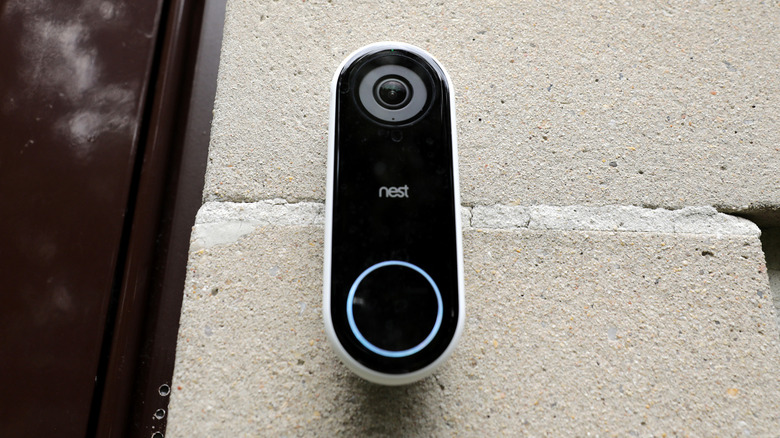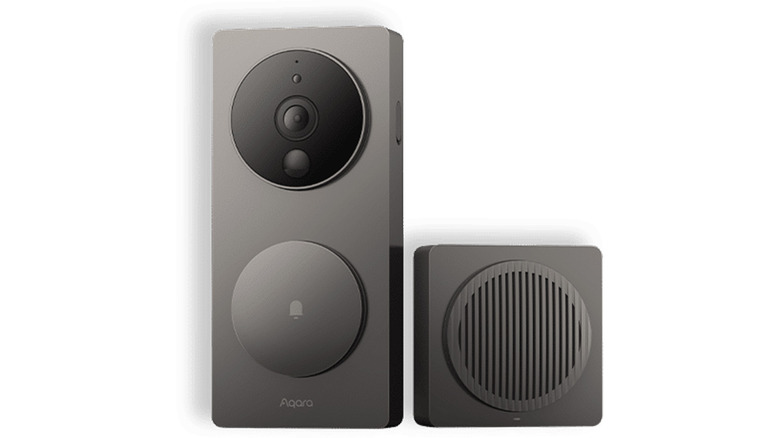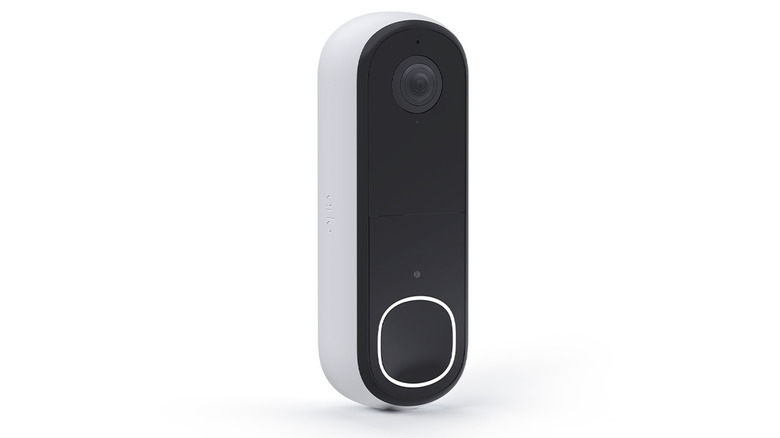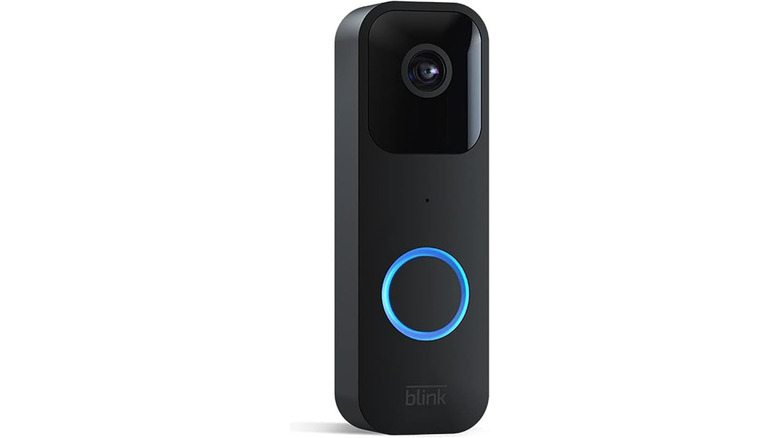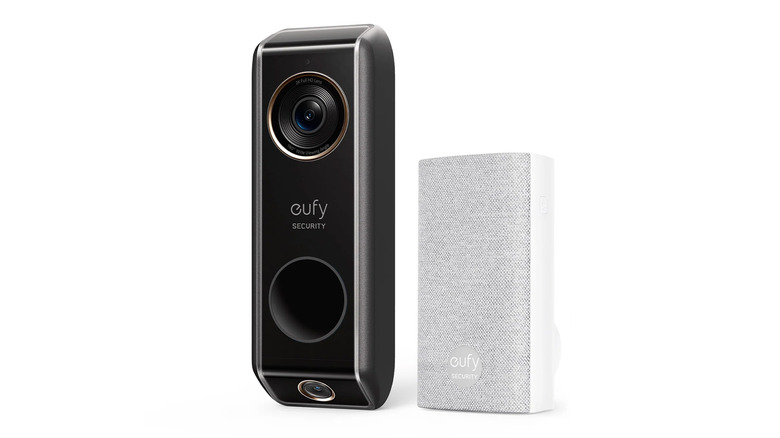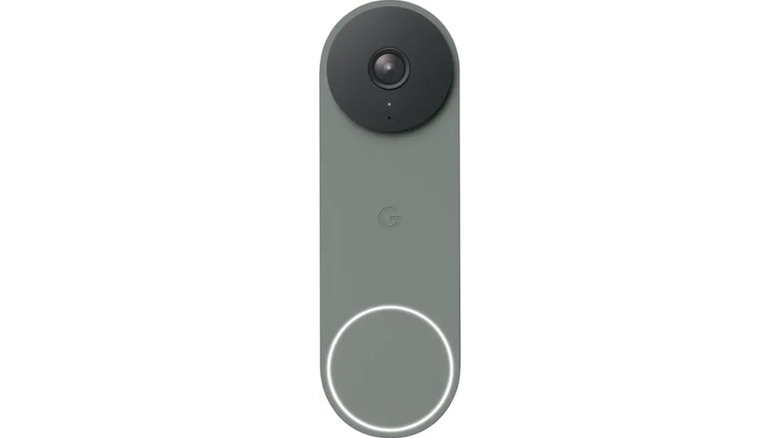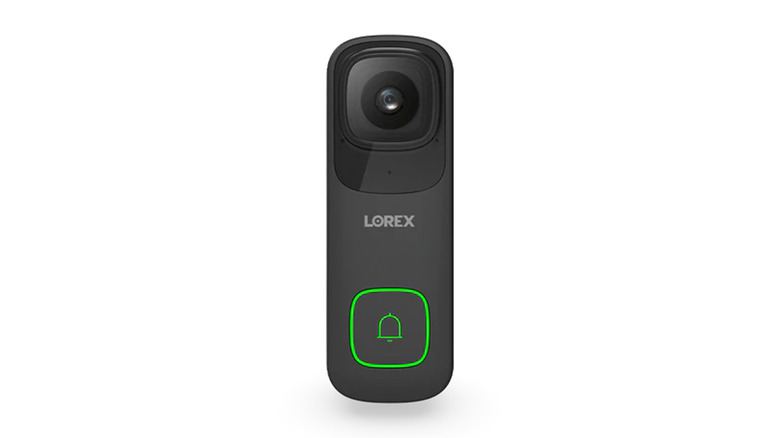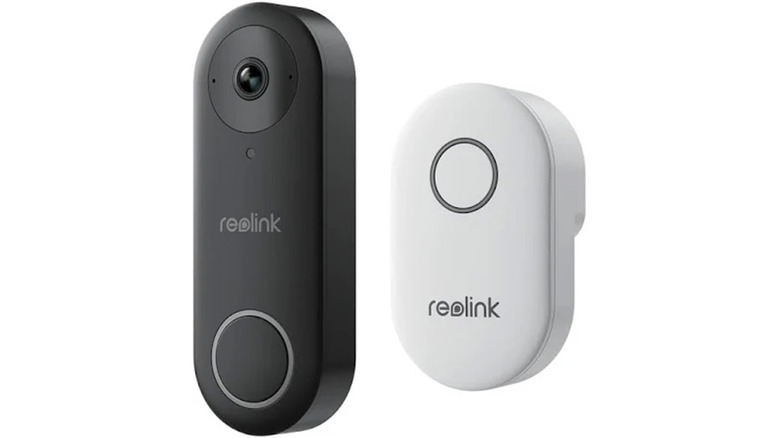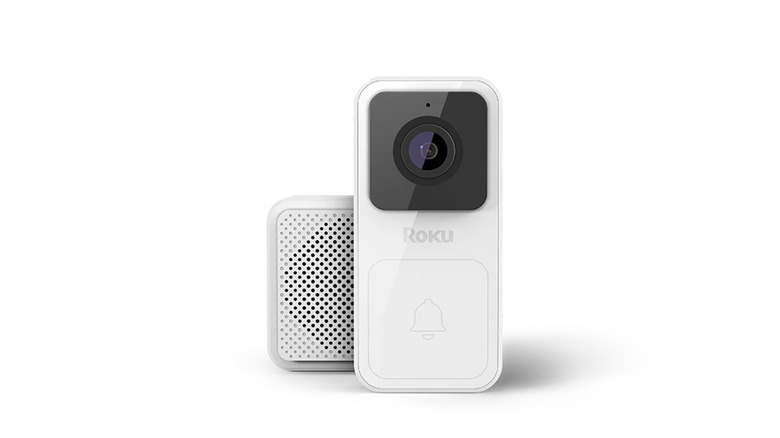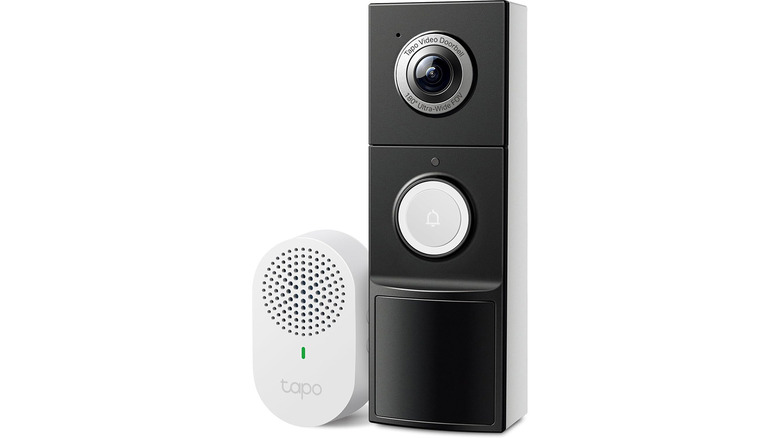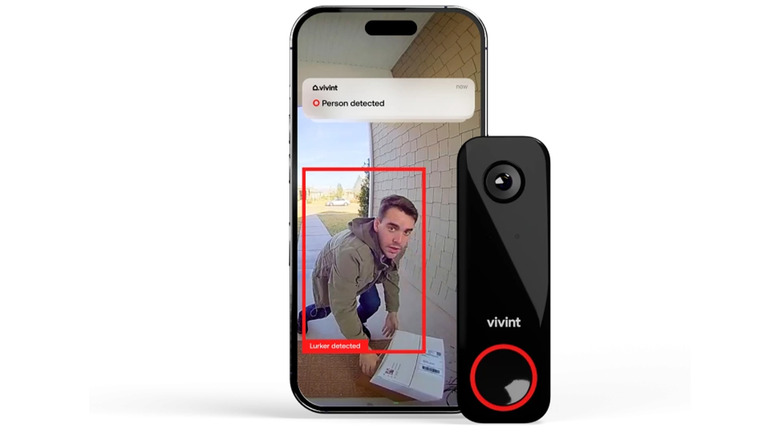10 Of The Best Brand Alternatives For Ring Doorbells
We may receive a commission on purchases made from links.
The Ring video doorbell is one of the most popular products in its category. Invented by Jamie Siminoff as a substitute for the regular doorbell, Ring would eventually come to include Shaq as an investor along with Richard Branson before being bought out by Amazon for $1 billion. Since then, Ring's product library has grown substantially and now includes video doorbells, indoor and outdoor cameras, alarms, smart lighting, and more. It is often mentioned among the top contenders when it comes to the best video doorbells that money can buy.
However, the Ring video doorbell collection isn't everyone's cup of tea. There are affordable Ring doorbells but prices for the best ones can range up over $300, which is more expensive than typical for a video doorbell. In addition, while some of the basic functions work without a subscription, you'll need one to record video, receive rich notifications, and get person or package alerts. The subscriptions can be costly as well, ranging upwards of $20 per month. That version of the subscription does include some goodies like 24/7 professional monitoring and some other features.
The subscription requirement is something that sticks in the craw of many potential customers, especially the cloud-based recording since many competitors offer onboard storage for local recording as well. That has sent many video doorbell customers out looking for Ring alternatives. Fortunately, there are dozens to choose from, giving consumers more options than ever before. Since people's wants and needs vary, we're listing the doorbells in alphabetical order so as not to paint a picture that one is any better than the other — especially since they're all pretty decent at what they do.
Aqara G4 Smart Video Doorbell
Aqara doesn't have the clout of the big-name brands, but the company still makes some decent video doorbells. Their main product is the Aqara G4 Smart Video Doorbell. This one can be either a wired or battery-powered doorbell, giving users plenty of options when it comes to installation. It also supports Apple HomeKit along with Amazon and Google smart displays, which makes it a viable pick for nearly any smart home setup. It also comes with an included chime so you can hear the doorbell on your phone or in your house.
In terms of specs, the G4 does pretty well. It only has an HD option, so no 2K video on this one. It makes up for it in other ways. It has a 162-degree field of view, giving you ample coverage of your front porch. It also comes with a host of automations and customizations to give you options on how to set up your doorbell. Unlike most, Aqara gives users seven free days' worth of cloud recording without a subscription along with local storage, so you'll have a backup if anything happens. There is also an anti-tamper mechanism that records and uploads the most recent six seconds if it detects that anyone is messing with your doorbell.
For the most part, that covers all of the bases. It supports micro-SD cards up to 512GB, which is plenty of video storage. The above features also function without a subscription, so you won't have to spend any additional money to use your doorbell.
Arlo Video Doorbell 2K
Arlo also makes good video doorbells. They have one of the better battery-operated video doorbells on the market with the Video Doorbell 2K, which can also be wired to your house if you want to go that route. It is currently the only doorbell that Arlo offers, which it does in two flavors. You can get the 2K or the HD version. We'll talk about the 2K version since it's the top-of-the-line model from Arlo. Fortunately, it's a pretty solid overall product.
The Arlo 2K Video Doorbell competes favorably with several Ring doorbells by featuring 2K video support and a 180-degree field of view. That means your camera will look sharp most of the time and the higher field of view lets you see people from head to toe on your video feed or even see packages that nestled up against the house. You also get night vision, motion detection, two-way audio, and an integrated siren. Since it connects directly to your router, you won't need a hub to use the Arlo 2K.
The only downside is, like the Ring doorbells, you need a subscription for most things. No subscription lets you talk to people through the doorbell, live stream your doorbell, and get push notifications when your camera detects motion. The subscription enables cloud recording and myriad other features. Arlo also lets you record video local storage, but you have to jump through some hoops to do it and not every model is supported so make sure to double check before making a purchase.
Blink Video Doorbell
Amazon owns Ring, so it's a little funky that it also owns the Blink brand of video doorbells. Blink represents Amazon's budget lineup of video doorbells, meaning the biggest benefit to a Blink is that the device itself is less expensive. As of this writing, the Blink Video Doorbell costs $59.99 on Amazon, which undercuts most other name brand competitors by a fairly hefty margin. It also has a sleek design that looks nice, so it definitely doesn't look as inexpensive as it is.
When it comes to features, Blink does pretty well for its price tag. It offers HD video, IP54 dust and water resistance, and comes in both wired and battery configurations. You also get plenty of modern features like alerts, motion detection, two-way audio, and more. Those who opt to add a Sync Module to the works gives you some more benefits. Of note is the Sync Module 2, which allows you to save local video recordings without a subscription plan. The modules can also control other Blink products in the same household, so it's probably worth shelling out for one if you plan on using Blink's other products.
In terms of subscriptions, Blink has them and they are similar to Ring's. Without a subscription or a Sync Module, you'll get motion activated notifications and five minutes of live view. Adding the basic subscriptions adds the stuff you actually want like motion event recording, live view recording, and other features. There is also a Plus level plan that adds a few more perks. If you wanted an Amazon product that could record without a subscription, though, the Blink with a Sync Module 2 will do the trick.
Eufy Smart Doorbells
Eufy is a major player in the video doorbell game and has multiple products that compete with Ring. Some of the options include Eufy's budget option, the C210 Video Doorbell. There is also the premium battery-powered E340 along with the premium wired option, the S330. Don't ask us why it shares a name with the S330 smart door lock, but it does. Rounding out the options is the S220 Video Doorbell.
There is a lot to unpack so let's get right down to it. The E340 is the highest-end battery doorbell that Eufy offers. It comes with two cameras with one pointing down at your porch floor to see any package, even if it's resting against the house. It also features color night vision, 2K resolution, and there is an optional wired version if you want to go that route. The S330 is essentially the same product but it doesn't have a battery option. The S220 is a more traditional solo camera option that uses a Sony 2K sensor for its video. Finally, the C210 is a less expensive C220 with a downgraded 1080p camera.
The good news is that you don't need a subscription for any of them. They all come with local storage options out of the box, although depending on the model you may need a hub to help you control them. That said, Eufy is far from a flawless brand and many of their products don't support Apple HomeKit or Matter, which limits their compatibility.
Google Nest Doorbell
The Google Nest Doorbell is arguably Ring's biggest competitor in this space right now. Google takes the opposite approach of Eufy and only offers two doorbells as of this writing — the Nest Doorbell Wired and the Nest Doorbell Battery. They are virtually identical in terms of specs but one is wired and the other is powered by batteries. The battery version is also a little larger to accommodate its battery. They are easy to find on store shelves as Google has done a good job making them widely available. They also cost about as much as Ring camera.
In terms of specs, the Nest Doorbell does pretty well. It features a 145-degree field of view along with an HD resolution. It also features HDR, above average night vision, and plenty of customizable settings. Google leverages a lot of its software chops for the Nest Doorbell, so you get better than average object recognition and the camera can even independently recognize animals along with the usual stuff like vehicles, people, motion detection, and packages. There is even special mounting hardware to help the doorbell see your porch more efficiently. In short, it's a good package, even if it doesn't have the biggest numbers on the spec sheet.
The Nest Doorbell is a sideways move when it comes to subscriptions. The doorbell can locally store about three hours of video without a subscription and things like motion detection are free as well. However, like Ring, storage isn't user expandable, so you'll have to pay either $8 or $15 per month for the Nest Aware subscription. Adding it grants 10 days of 24/7 video recording along with some other features. However, make sure to read the fine print as some features don't work the same way on the battery model as they do on the wired model.
Lorex 4K Wi-Fi Video Doorbell
Lorex is an interesting option for video doorbells. The brand sells several different models of its video doorbell but for this list we'll be focusing on the Lorex 4K Wi-Fi Video Doorbell. It's a wired video doorbell that boasts a lot of helpful features. If you want a battery powered model, Lorex also sells a 2K doorbell model that does just that. It's the first such doorbell on the market that can go up to that high of a resolution. It also comes in black or white so you can match it to your house a little better.
The Lorex 4K Video Doorbell has a fairly strong spec sheet. On top of its high resolution, the doorbell offers detection of various objects, color night vision, a full head-to-toe view, a night light, and two-way talk with a quick response message feature. It also comes with a 32GB micro-SD card installed by default which is user upgradeable to 256GB. As such, it can store quite a bit of video locally. Its unique 9:16 aspect ratio is a bit less wide than most other doorbells, but it does get more vertical view. It may or may not be preferable depending on your home's porch but it is something different than what you'll typically see.
Not only does Lorex give you all of that without a subscription, but the company doesn't even offer a subscription or even a hub. There are downsides to that, such as a lack of cloud storage, but if you want something that doesn't rely on the cloud at all, this is one of your best bets.
Reolink Video Doorbell
Reolink does something a little bit different with its doorbells. Instead of offering the same doorbell in multiple colors, it uses its color choices to offer slightly different products. In this instance, the black variant offers a 4:3 aspect ratio that covers a more horizontal view while the white variant is a 3:4 aspect ratio, which offers more vertical coverage. Much like the Google Nest Doorbell, it also comes with an adjustable wedge to help the doorbell get the most advantageous view.
Despite being a more budget-oriented brand, Reolink packs quite a bit of value into its doorbells. You get 2K resolution, the usual array of alerts, and it'll save six seconds before any given alert so you can see what was happening immediately prior to the alert. Unlike most competitors, it also has a few different ways to record video, including a Reolink NVR along with support for FTP and NAS servers in addition to its included micro-SD card. Such options would be a boon to the DIYer looking to make their own storage setup instead of being reliant on the cloud. Reolink doorbells are also compatible with Amazon Alexa, Google Assistant, and Apple HomeKit.
There is an available Reolink subscription that ranges from $6.99 per month to $15.99 per month that adds some additional features like cloud storage and rich notifications. However, it's not necessary to use one given the expansive storage options that Reolink offers. So, if the subscription is the deal breaker for you when it comes to Ring, Reolink is a decent overall choice as a substitute.
Roku Video Doorbells
Roku's Video Doorbell is a bit more niche than some other products since it works best in a household with other Roku products. However, it's a decent little video doorbell that can be a good Ring alternative if you have those other Roku devices. Roku sells two such doorbells. The first is a wired doorbell that runs for $79.99 and the other is a battery powered doorbell that costs $119.99. Roku keeps it simple when it comes to choices.
As you might expect from the price, the battery doorbell has a better spec sheet than the wired doorbell. Both can do things like live streaming video to your Roku TV along with things like smart alerts, motion detection, and sound alerts. Both also feature color night vision, an IP65 water and dust resistance rating, and more. The battery doorbell offers video in up to 1440p with a 150-degree field of view while the wired variant is 1080p with a 120-degree field of view. Those are about the only two differences between the cameras that we could find.
Roku does require a subscription for many of its features, including any type of detection along with video storage. That's a little bit of a bummer but Roku does cost less per month than Ring at $3.99 instead of Ring's $4.99 base price. This option is likely only better if you plan on going with Roku in your home for other tech as well. Otherwise, you may be better suited for one of the other options.
TP-Link Tap Smart Video Doorbell
The TP-Link Tapo Smart Video Doorbell is a reasonable choice for budget-conscious shoppers. It goes for under $100, albeit just barely, and is often on sale. TP-Link sells five models of its Tapo video doorbell which range from the D130 to the TD25. One of them is hardwired with no battery, two of them are battery-only, and the final two can be powered by wire or by battery. For the most part, any of them will do the trick, but one variant, the TD25, is a Best Buy exclusive, so if you want the best version of TP-Link's tech, you'll need to buy it there.
The specs and features depend on which variant you go for. The D130, D225, and TD25 all feature a 180-degree field of view, which is among the best in the segment. The other two have a 160-degree field of view. All five doorbells can do 2K recording and the ones that are hardwired all have 24/7 recording available as a feature. TP-Link also offers line-crossing motion detection along with tamper resistance on most of its models, which is unique in the video doorbell segment. For their respective price points, TP-Link offers quite a bit with their video doorbells.
TP-Link gives you all of the above features without a subscription, which is the strongest selling point when cross shopping between Ring and Ring's various competitors. Users can install a micro-SD card up to 512GB to record video without the need for cloud storage and the other features work out of the box. Between its cheaper price tag and local storage capability, TP-Link makes a strong case as a Ring alternative.
Vivint Doorbell Camera Pro
Vivint is an interesting option for video doorbells. You can't really buy the doorbell on its own unless you buy it second-hand from eBay or similar retailers. It comes as part of a larger security package that is installed and run by Vivint. The way it works is you go to Vivint's website and choose your security bundle, most of which contain the video doorbell. It's also available on less expensive packages as an add-on. Vivint sends the tech, someone installs it, and then you have a full security system in your house. You then pay for the whole package on a monthly basis starting at $17 per month and ranging up to $28 per month.
In terms of specs, the video doorbell is fairly decent. It boasts the same package and people detection of its competitors. The big treat is its field of view, which is 180-degrees in both directions, giving you the widest angle of any doorbell on this list. Much like TP-Link, it also allows for line-crossing detection that you can customize, so for example, if you only want detection notifications when someone physically reaches your porch, you can do that. In all, it's a good video doorbell.
Vivint also includes other tech with their packages, like window sensors, smoke and carbon monoxide detectors, and even water sensors. It's much more expensive than Ring overall, but you get the benefit of a company coming out and doing all the work for you and all you have to do is pay them. Depending on your lifestyle, it's not a bad deal.
